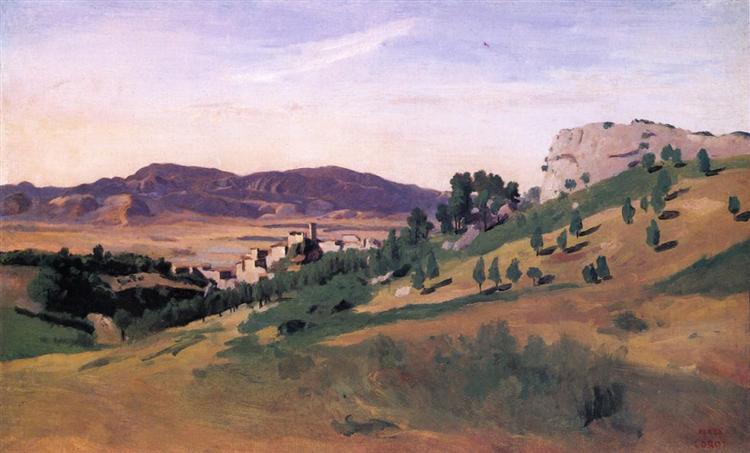描述
Camille Corot's painting "Olevano - The City and the Rocks", painted in 1827, stands out as a sublime example of the connection between nature and architecture, inspired by the stunning town of Olevano Romano in Italy. This work, like many of Corot's creations, evokes a soft light and a serene atmosphere, offering the viewer an intimate glimpse into a landscape that transcends the merely representational. Corot, a master of landscape, delves into a fusion between realism and the lyrical qualities that characterize both his work and the Romantic movement.
Looking at “Olevano”, the composition reveals a harmonious balance between natural and man-made elements. The high cliffs that frame the town have a dominant verticality, contrasting with the horizontality of the sky above. The rocks, with their texture and clearly defined details, seem to come to life, acting as guardians of the town that sits at their feet. The arrangement of the buildings, with their red-tiled roofs and the mass of the constructions, highlights the intimate relationship of the human being with his natural environment, creating a space where the urban and the wild coexist in a state of peace.
The use of colour is fundamental in this work. Corot uses a predominantly warm palette, sprinkled with greens and ochres that provide an air of warmth and nostalgia. The light that filters through the clouds, creating an ethereal atmosphere, highlights the romantic character of the landscape, emphasizing a fleeting moment that invites contemplation. The representation of the sky, with its delicate shades of blue mixed with soft clouds, not only provides an environmental context, but also suggests a broader, spiritual universe, inviting the viewer to reflect on the sublime beauty of the surroundings.
As for the human presence in the work, it is interesting to note that Corot often chose not to include figures in his landscapes, reinforcing the idea of the grandeur and immensity of nature as opposed to humans. However, the absence of figures can also suggest an invitation for the viewer to become part of the scene, in a silent dialogue between the observer and the landscape. This intentional denial of the human figure emphasizes the awe and reverence that the artist felt for natural environments, thus achieving a deep sense of belonging and reflection.
"Olevano - The City and the Rocks" aligns itself with the classical landscape tradition, but Corot's interpretation adds a layer of subjectivity and emotion that sets it apart. His loose brushstroke technique and use of color to evoke emotional sensations prefigure what Impressionism would later develop. Contemporary paintings that developed this notion of light and color, such as the works of Monet or Renoir, show the influence Corot had on these later movements, as well as his crucial place in the evolution of landscape in Western painting.
In short, Corot's work not only captures an instant and a place, but also invites a contemplative experience that enriches our connection with nature. "Olevano - The City and the Rocks" stands as a testament to how the landscape can be both a physical place and an emotional space, reflecting the beauty and fragility of human existence in the face of the vast magnificence of the natural world. With his technical mastery and poetic sensitivity, Corot positions himself as a central figure in the history of art, whose influence continues to resonate in contemporary works.
KUADROS ©, a famous painting on your wall.
Hand-made oil painting reproductions, with the quality of professional artists and the distinctive seal of KUADROS ©.
Painting reproduction service with satisfaction guarantee. If you are not completely satisfied with the replica of your painting, we will refund 100% of your money.

